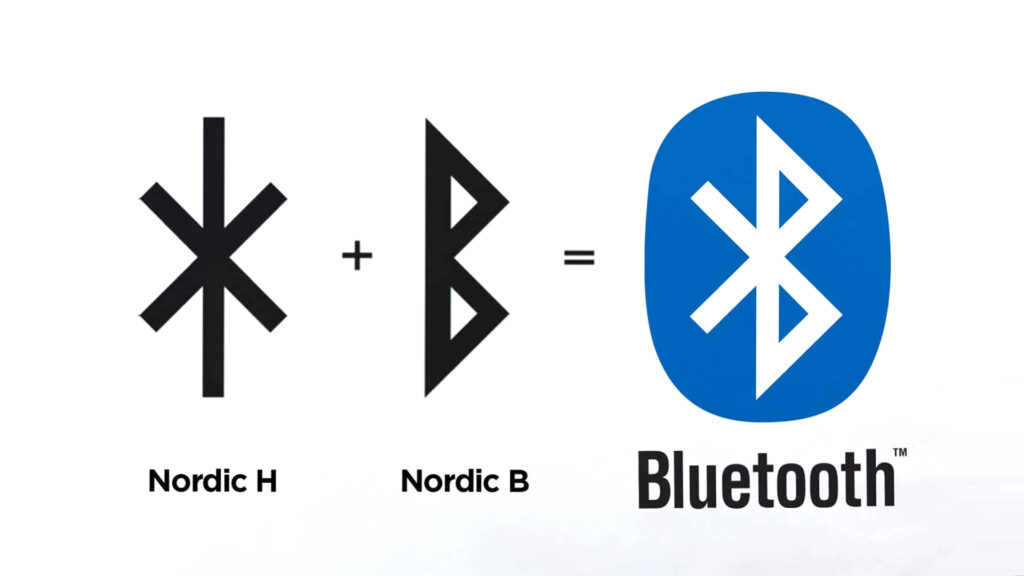The Amazing Story Behind the Bluetooth Logo
The Bluetooth Logo is universally recognizable since showing up on just about every smart device in the early 2000s. But have you ever wondered where the name and logo came from? In this episode, we talk about “Harald Bluetooth” the Viking and why his name was used for the technology. Then we chat with Comedian & Magician Matt Donnelly!

The country of Denmark is named Denmark because that’s an old Norse word for “The Marches of the Danes.” Originally it was known as “Danmark” and common folklore tells a story about it being named after “King Dan,” who was sort of a mythological first king of the area. But there’s no one real person that we can point to who was “King Dan.”
But Denmark as a nation was a unification of a bunch of different lands in the area – including what we now know as Norway and Sweden. The unification of the country saw its first official unified King somewhere in the 10th century by a Viking King, Gorm the Old, and then by his son Harald. Harald is the Viking King of Denmark that’s credited with really uniting the lands as well as introducing Christianity to Denmark. He ruled from 958 to 986.
We have a great reminder of these Danish Kings. If you visit the railway town of Jelling, Denmark, you’ll find the earliest written mention of the name of the country. Two large stones known as the Jelling Rune Stones. These stones were placed by Gore the Old and his son Harald and they are covered with inscriptions of ancient norse runes, including the name “Danmark.” The stones are absolutely huge, considering they were placed there in the 10th century. The larger of the two stones was placed by the son, Harald, and has an inscription: “King Harald bade this monument be made in memory of Gorm his father and Thyra his mother, that Harald who won for himself all Danmark and Norway and made the Danes Christians”.
And it was the joining of nations, the joining of Denmark with Christianity, that Harald is known for. And it turns out we still say his name every day. Because Harald’s last name, as inscribed in the Jelling Rune Stones, was Bluetooth. Harald Bluetooth.
What we know of Harald comes from the Rune stones, but also from several contemporary accounts of his reign as the first Christian King of Denmark. One source called him, “remarkable by the force of his mind and faith,” but other sources from the time called him “deprived of wisdom,” or “without great intelligence.” His last name was Gormsson – he was the son of Gorm – but he was known throughout his life with the nickname name Blåtand, which translates to “Blue Tooth.” Harald, its believed had a dead tooth that appeared black or blue in his mouth. Other legends describe his love for eating berries, staining his teeth blue. Whichever story is true, his nickname became his last name, and Harald Bluetooth the Viking became known as the first Christian King of Denmark and the man who united the country.
So how did a Viking King of Denmark end up being immortalized 1,000 years later and linked to technology he could have never dreamed of?
For this part of the podcast, we’re going to forget the ancient Danes for a minute and skip forward 1,000 years.
In 1994, Ericsson Mobile, the Swedish tech company, was working on an idea for a wireless headset to work with their phones. They were building off a couple earlier patents from Johan Ullman and this team consisting of Nils Rydbeck, Todd Wingren, Jaap Haartsen, Sven Mattison and Örjan Johansson. They teamed up with the other major mobile technology companies. IBM, Nokia, Toshiba and Intel all joined Ericsson in working on this project. The goal was to unite the PC and Cellular industries in creating this sort of “Short-link radio” signal to help devices talk to each other within a small area.
They considered several possible names for the technology: Biz-RF, MC-Link, Low-Power RF, and the project name that was most commonly used: Personal Area Networking (PAN). The resulting technology allowed a device with 10 feet of the primary unit to receive and send communication signals over Radio Frequency. Of course, this has since expanded to somewhere around 100 feet, but the original signal could only travel around 10 feet.
It was time to market this new technology that could allow things like headsets to wirelessly pair with mobile phones and they didn’t like the name PAN because it seemed way too broad and difficult to patent and market. That’s where Jim Kardach comes in.
Kardach was an Intel Engineer and thought that a challenge they were all facing presented an interesting story to tell. The major problem was that all these communication technology companies were using different standards for cell phone connectivity. Kardach ran the group that brought together engineers from all these different companies – at the time they called it “SIG” for “Special Interest Group.” It was Kardach that had heard the legend of how Harald Bluetooth had united the different lands to form Denmark and thought that unification was exactly what was needed here. So he lightly started calling his group “Bluetooth SIG” and later just “Bluetooth.” It was a project name – just a name to be used internally to describe the project. But it stuck.
Just like Harald Bluetooth had joined together different people with different customs, this special interest group developed a technology that could converge not only PC tech with networking and communication, but also multiple different telecom companies, countries and standards into a tool that could be used widely by all of them. So when the first products to include it were released – The Ericsson R520M and T39 phones, they were able to be paired using the technology they released with the name “Bluetooth.” Soon, wireless earpieces started showing up on shelves like Nokia’s HDW-1 in 1997 and HDW-2 in 2003.
But what about that logo? The bluetooth logo is something that we all see just about every day, whether it be on our computers, gaming systems, phones or TVs. It looks like an alien symbol. And it comes from the very place where the name Bluetooth was taken: the rune stones in Jelling, Denmark. Harald Bluetooth’s initials, HB, are used on that stone in the Futhark rune language; the H appearing as a symbol that looks like a line with a small X through the middle, and the B looking like what we know as a b, but without any curves. If you stick those two runes together, using the left half of the H and sticking it to the side of the B, you get what we now know as the Bluetooth logo.

Today, Jim Kardach – one of the founders and the namer of Bluetooth is semi-retired. He has taught at Cal State, but also works part time with a few other tech companies. He left Intel as Chief Power Architect in 2012. And as you know, any wireless communication device now carries the initials of this ancient Danish Viking King. It sounds made up, but it’s true. Bluetooth is named after Harald Bluetooth. The Internet Says it’s True.

Review this podcast at https://podcasts.apple.com/us/podcast/the-internet-says-it-s-true/id1530853589
Bonus episodes and content available at http://Patreon.com/MichaelKent
For special discounts and links to our sponsors, visit http://theinternetsaysitstrue.com/deals

